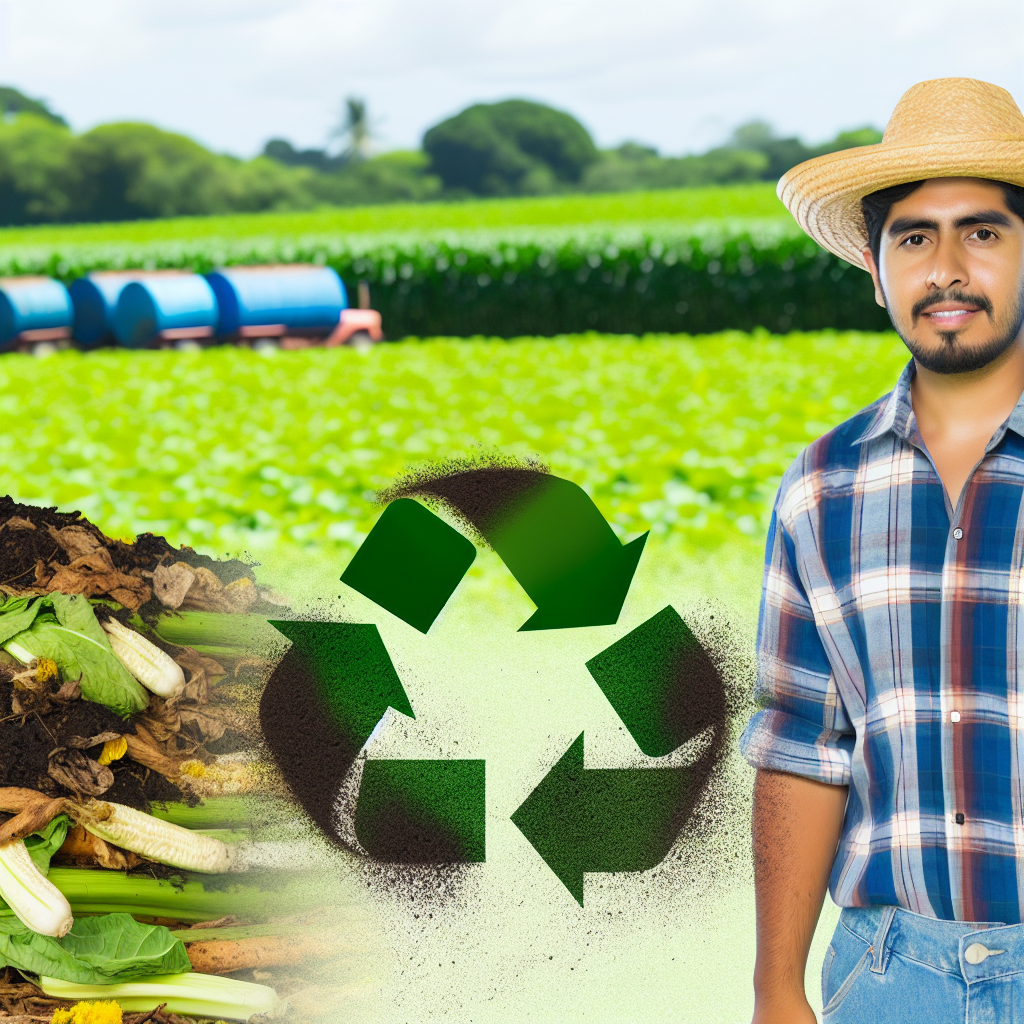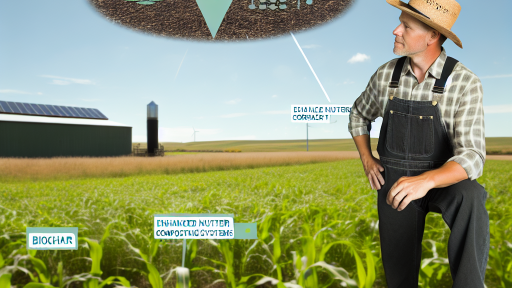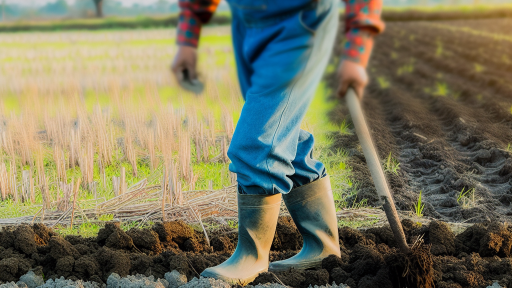Introduction to Natural Recycling in Agriculture
Natural recycling methods enhance the sustainability of agricultural practices.
These techniques efficiently reduce agricultural waste.
Farmers increasingly seek ways to recycle organic materials.
Natural recycling integrates waste management within farming systems.
Understanding Agricultural Waste
Agricultural waste consists of residues from crop production.
It also includes by-products from animal farming.
Improper disposal of this waste poses environmental risks.
Recycling agricultural waste can turn it into valuable resources.
Benefits of Natural Recycling
Natural recycling promotes soil health and fertility.
It reduces the need for chemical fertilizers.
Furthermore, it minimizes the carbon footprint of farming operations.
Farmers can save costs by repurposing waste materials.
Methods of Natural Recycling
Several effective methods exist for recycling agricultural waste.
Composting is one popular approach.
This process transforms waste into nutrient-rich organic matter.
Transform Your Agribusiness
Unlock your farm's potential with expert advice tailored to your needs. Get actionable steps that drive real results.
Get StartedCover cropping also aids in recycling nutrients back into the soil.
Case Studies of Successful Implementation
Many farmers successfully implement natural recycling methods.
For instance, Gabriel Farms in California uses composting extensively.
They observed improved soil quality and increased crop yields.
Another example includes Green Pastures, which employs cover cropping.
Challenges in Natural Recycling
Despite its benefits, natural recycling faces challenges.
Not all farmers are familiar with these techniques.
Additionally, an initial investment may be required for implementation.
Education and support are essential for overcoming these barriers.
Types of Agricultural Waste Generated
Crop Residues
Farmers generate crop residues after harvesting various crops.
These residues include stalks, leaves, and husks.
They often remain on fields, becoming vital organic matter.
Proper management of crop residues enhances soil health.
Animal Manure
Animal manure is another significant source of agricultural waste.
Farmers produce it from livestock such as cows, pigs, and chickens.
Manure contains valuable nutrients beneficial for soil fertility.
Yet, improper disposal can lead to water pollution issues.
Processing By-Products
Agricultural processing generates various by-products.
Examples include bran from milling grains and pulp from juicing fruits.
These by-products often go unused, despite their potential value.
Recycling these materials can lead to sustainable practices.
Pesticide Containers and Chemical Waste
Pesticide usage results in empty containers and leftover chemicals.
Improper disposal of these can harm the environment.
Farmers must adhere to guidelines for safe disposal.
Showcase Your Farming Business
Publish your professional farming services profile on our blog for a one-time fee of $200 and reach a dedicated audience of farmers and agribusiness owners.
Publish Your ProfileRecycling programs can mitigate these impacts effectively.
Plastic Waste
Plastics used in agriculture create substantial waste challenges.
Common plastic items include wraps, containers, and irrigation tubes.
Many of these plastics are not biodegradable.
Implementing recycling initiatives can reduce plastic impacts.
Benefits of Natural Recycling Methods
Environmental Advantages
Natural recycling methods significantly reduce waste in agriculture.
They minimize pollution and lower the carbon footprint.
Moreover, these methods enhance soil health and fertility.
This process supports biodiversity and promotes ecosystem resilience.
Economic Benefits
Implementing natural recycling methods can lower operational costs.
It reduces the need for chemical fertilizers and synthetic pesticides.
Farmers can generate additional income by selling recycled products.
Additionally, it boosts the long-term viability of agricultural operations.
Enhanced Crop Yields
Natural recycling methods improve soil structure and nutrient availability.
This leads to healthier plants and increased crop productivity.
Healthy soils retain moisture better, reducing irrigation needs.
Consequently, farmers can achieve more consistent harvests.
Community and Social Impact
These methods foster community engagement in sustainable practices.
Local farmers can collaborate on waste recycling initiatives.
This collaboration enhances community ties and knowledge sharing.
Furthermore, sustainable practices improve food security for communities.
Climate Resilience
Natural recycling promotes resilience against climate change impacts.
Healthy soils can better withstand extreme weather conditions.
This resilience affects the stability of food systems positively.
As a result, farmers can adapt to shifting climatic conditions more effectively.
Uncover the Details: Organic Water Conservation Methods for Farmers
Composting Techniques for Agricultural Waste
Introduction to Composting
Composting transforms agricultural waste into nutrient-rich soil amendments.
This process speeds up natural decomposition.
Farmers can use compost to enhance soil fertility.
Benefits of Composting
Composting reduces waste disposal costs.
It lowers greenhouse gas emissions from landfills.
Moreover, composting enriches the soil structure.
Healthy soil improves crop yield and quality.
Types of Composting Techniques
Several techniques exist for effective composting.
Let’s explore some popular methods.
Heap Composting
This traditional method involves piling organic waste together.
The pile decomposes over time due to microbial activity.
Heap composting is simple and cost-effective.
Tumbler Composting
Tumblers are enclosed containers that rotate.
They facilitate aeration and mixing of materials.
Showcase Your Farming Business
Publish your professional farming services profile on our blog for a one-time fee of $200 and reach a dedicated audience of farmers and agribusiness owners.
Publish Your ProfileUsing a tumbler speeds up the composting process.
Bokashi Composting
Bokashi uses anaerobic fermentation to decompose waste.
This method utilizes beneficial microorganisms.
Bokashi compost retains nutrients effectively.
Materials for Composting
Choosing the right materials is crucial for successful composting.
Common green materials include vegetable scraps and grass clippings.
Brown materials like dried leaves and straw provide carbon.
Balancing these materials promotes efficient decomposition.
Composting Process Steps
Follow these steps for effective composting.
First, gather your organic materials.
Next, layer greens and browns in your compost pile.
Maintain moisture to encourage microbial activity.
Turn the pile regularly to aerate it.
Finally, monitor the temperature and wait for decomposition.
Maintaining Your Compost
Regular maintenance ensures successful composting.
Check for adequate moisture levels frequently.
Turning the compost promotes better aeration.
Watch for foul odors, which indicate anaerobic conditions.
Using Finished Compost
Once compost is dark and crumbly, it is ready for use.
Incorporate it into garden soil to improve fertility.
Use compost as a top dressing for established plants.
Additionally, it can serve as a potting mix additive.
Gain More Insights: IPM Techniques to Combat Common Crop Pests
Utilization of Crop Residues in Soil Health
Importance of Crop Residues
Crop residues play a crucial role in enhancing soil health.
They contribute organic matter to the soil ecosystem.
This organic matter improves soil structure and fertility.
Moreover, it helps retain soil moisture effectively.
Enhancing Nutrient Availability
As crop residues decompose, they release essential nutrients.
This process enriches the soil, benefiting future crops.
Additionally, decomposition encourages microbial activity.
Microorganisms break down organic matter, further improving nutrient dynamics.
Preventing Soil Erosion
Covering the soil with crop residues prevents erosion.
This protection reduces loss of topsoil during heavy rainfall.
Furthermore, it promotes water infiltration, enhancing groundwater recharge.
Cultivation Methods using Crop Residues
Farmers can adopt various cultivation methods to utilize crop residues.
No-till farming is one effective technique.
This method preserves the soil structure and minimizes disturbance.
Additionally, integrating crop residues into the soil improves nutrient cycling.
Challenges in Utilizing Crop Residues
Despite their benefits, challenges exist in utilizing crop residues.
Farmers may face labor constraints during residue management.
Showcase Your Farming Business
Publish your professional farming services profile on our blog for a one-time fee of $200 and reach a dedicated audience of farmers and agribusiness owners.
Publish Your ProfileMoreover, improper incorporation can lead to pest issues.
It is essential to train farmers on best practices for residue use.
Community Involvement and Education
Engaging local communities enhances awareness about residue benefits.
Workshops can share effective techniques for managing crop residues.
Moreover, farmers can collaborate to share resources and tools.
This cooperative approach strengthens the agricultural community.
See Related Content: Water-Saving Technologies in Sustainable Agriculture
Biogas Production from Agricultural Waste
Introduction to Biogas
Biogas is a renewable energy source derived from organic materials.
It primarily consists of methane and carbon dioxide.
Agricultural waste provides an excellent feedstock for biogas production.
This process contributes significantly to waste management and energy generation.
Sources of Agricultural Waste
Agricultural waste includes various materials generated during farming activities.
Common sources are crop residues, livestock manure, and food processing waste.
These materials are often underutilized and can pose disposal challenges.
However, they are rich in organic matter, ideal for biogas production.
Crop Residues
Crop residues consist of leftover plant materials after harvest.
Examples include straw, husks, and leaves.
Instead of burning, farmers can convert these residues into biogas.
Livestock Manure
Livestock manure is a potent source of biogas due to its high organic content.
It includes dung from cattle, pigs, and poultry.
Proper management of manure through anaerobic digestion can generate methane.
Food Processing Waste
Food processing generates significant organic waste that can be harnessed.
This includes peels, pulp, and waste from fruit and vegetable processing.
Such waste can effectively be converted into energy through biogas plants.
Process of Biogas Production
Biogas production involves anaerobic digestion, a natural breakdown process.
Microorganisms decompose organic matter in the absence of oxygen.
This process occurs in specially designed digesters.
Digestion Stages
The anaerobic digestion process includes several stages.
First, hydrolysis breaks down complex organic materials.
Next, acidogenesis converts sugars and amino acids into organic acids.
Then, acetogenesis transforms organic acids into acetic acid, hydrogen, and carbon dioxide.
Finally, methanogenesis produces methane from acetic acid and other substrates.
Benefits of Biogas Production
Producing biogas from agricultural waste offers numerous advantages.
It reduces greenhouse gas emissions by decreasing waste decomposition in landfills.
Moreover, it provides a renewable energy source for heating and electricity.
Additionally, the byproduct, digestate, can be used as organic fertilizer.
Environmental Impact
Biogas production mitigates the environmental impact of agricultural waste.
It minimizes methane emissions that would otherwise occur from waste decomposition.
Using biogas as an energy source reduces reliance on fossil fuels.
Economic Benefits
Investing in biogas technology can be economically beneficial for farmers.
Showcase Your Farming Business
Publish your professional farming services profile on our blog for a one-time fee of $200 and reach a dedicated audience of farmers and agribusiness owners.
Publish Your ProfileIt creates a sustainable revenue stream from waste management.
Furthermore, using biogas can lower energy costs for agricultural operations.
Discover More: Crop Rotation Planning Methods For Sustainable Agriculture

Incorporation of Green Manure and Cover Crops
Understanding Green Manure
Green manure consists of cover crops grown specifically to improve soil health.
Farmers often till these crops back into the soil before planting main crops.
This method enhances organic matter and fertility in the soil.
Moreover, green manure helps prevent soil erosion and suppresses weeds.
Benefits of Green Manure
Using green manure offers numerous benefits for farmers and the environment.
- Improves soil structure and aeration.
- Adds nutrients, especially nitrogen, to the soil.
- Enhances water retention in sandy soils.
- Reduces compaction from heavy machinery.
Furthermore, green manure promotes microbial activity beneficial for growth.
Cover Crops for Soil Health
Cover crops are planted between main crop cycles to improve soil conditions.
These crops protect soil during off-seasons and prevent nutrient leaching.
They also contribute organic material as they decompose.
Farmers can choose various species, such as clover or rye.
Advantages of Cover Crops
Implementing cover crops brings multiple advantages to agricultural practices.
- Prevents soil erosion through root systems.
- Enhances soil nutrient cycling and retention.
- Outcompetes weeds, reducing herbicide use.
- Helps to break pest and disease cycles.
Additionally, cover crops can provide forage for livestock during the off-season.
Best Practices for Incorporating Green Manure and Cover Crops
Employing these practices requires careful planning and management.
Farmers should choose cover crops suited to their local climate and soil types.
Timing is critical for planting and terminating cover crops.
Moreover, integrating these crops into crop rotation improves overall efficiency.
Regular soil testing can inform nutrient needs and adjustments.
Role of Microorganisms in Naturally Recycling Waste
Microorganisms: The Unsung Heroes
Microorganisms play a crucial role in recycling agricultural waste.
They break down complex organic materials efficiently.
Additionally, these tiny organisms enhance soil fertility.
They contribute to nutrient cycling in the ecosystem.
Diverse Types of Microorganisms
Different types of microorganisms participate in waste recycling.
Bacteria are among the most prominent contributors.
They decompose plant material effectively.
Fungi also play an essential role in this process.
They break down tougher organic compounds like lignin.
Impact on Soil Health
Microorganisms improve soil structure and aeration.
They facilitate the organic matter decomposition process.
Consequently, they enhance nutrient availability for plants.
In turn, healthier soil promotes better crop yields.
Symbiotic Relationships
Many microorganisms form symbiotic relationships with plants.
Mycorrhizal fungi, for instance, aid in nutrient absorption.
These partnerships increase the resilience of crops.
Moreover, they help plants withstand environmental stressors.
Natural Composting Processes
Microorganisms drive the natural composting process.
This process transforms waste into nutrient-rich compost.
Composting also reduces greenhouse gas emissions.
Showcase Your Farming Business
Publish your professional farming services profile on our blog for a one-time fee of $200 and reach a dedicated audience of farmers and agribusiness owners.
Publish Your ProfileIncorporating compost improves soil health and fertility.
Sustainable Practices in Agriculture
Utilizing microorganisms supports sustainable agricultural practices.
Farmers should encourage microbial activity in their fields.
This can be achieved through crop rotation and cover cropping.
Maintaining diverse microbial populations enhances sustainability.
Case Studies on Successful Natural Recycling Practices
Composting in Organic Farms
Organic farms often utilize composting to recycle agricultural waste.
This method transforms food scraps and plant materials into nutrient-rich soil amendments.
Farmers like Maria Gonzalez emphasize using diverse organic matter.
They blend kitchen refuse with crop residues to enhance microbial activity.
This practice boosts soil fertility and reduces waste disposal costs.
Moreover, the final compost improves crop yields significantly.
Utilization of Cover Crops
Many farmers integrate cover crops into their crop rotation systems.
Cover crops, such as clover and rye, enrich the soil as they grow.
In Wisconsin, John Thompson implements this practice effectively.
Cover crops prevent soil erosion and suppress weeds.
They also contribute organic matter when tilled back into the soil.
This method enhances nutrient cycling and improves soil health overall.
Livestock Manure Recycling
Poultry and livestock farms often manage waste through recycling methods.
For instance, Emily Carter’s dairy farm utilizes manure as a fertilizer.
She applies it directly to fields, which reduces chemical fertilizer dependence.
This practice closes nutrient loops and minimizes environmental impact.
Additionally, composting manure helps manage pathogens and odors.
Agroforestry Practices
Agroforestry combines agriculture with forestry for mutual benefits.
Charles Wu in Oregon showcases this technique by planting trees alongside crops.
These trees provide shade, improve biodiversity, and reduce soil erosion.
Additionally, fallen leaves and branches serve as natural compost.
This approach enhances nutrient recycling while promoting sustainable land use.
Biogas Production from Organic Waste
Farmers increasingly turn to anaerobic digestion for organic waste recycling.
In California, the Green Valley Farm leverages biogas technology.
This system converts livestock manure into renewable energy.
Furthermore, the remaining digestate enriches soil fertility as fertilizer.
This method significantly reduces greenhouse gas emissions and energy costs.
Challenges and Solutions in Implementing Natural Recycling Methods
Identifying Common Challenges
Farmers often face practical obstacles in adopting natural recycling methods.
Limited access to resources can hinder implementation efforts.
Additionally, inadequate knowledge about these methods poses a significant barrier.
Weather conditions may also affect the practicality of these approaches.
Cultural resistance can prevent farmers from changing long-standing practices.
Developing Effective Solutions
Education programs can help bridge knowledge gaps in natural recycling methods.
Providing access to resources is essential for successful implementation.
Cooperative models can facilitate shared knowledge among farmers.
Showcase Your Farming Business
Publish your professional farming services profile on our blog for a one-time fee of $200 and reach a dedicated audience of farmers and agribusiness owners.
Publish Your ProfileLocal governments should promote policies that enhance resource availability.
Creating demonstration projects can showcase successful practices.
Encouraging Community Involvement
Community involvement fosters support for natural recycling initiatives.
Farmers can collaborate with researchers to share valuable insights.
Building networks among farmers encourages the exchange of best practices.
Workshops and seminars can stimulate interest and engagement.
Integrating Technology
Embracing technology can enhance natural recycling methods.
Innovative tools can support efficient waste management practices.
Monitoring systems may help track progress and effectiveness.
Furthermore, mobile applications can provide timely information and resources.
Measuring Impact and Success
Implementing clear metrics can help measure the success of recycling methods.
Regular assessments allow for adjustments where necessary.
Sharing success stories can inspire wider adoption among farmers.
Ultimately, positive results encourage others to give natural recycling a try.
Additional Resources
Fact Sheet | Biogas: Converting Waste to Energy | White Papers | EESI




